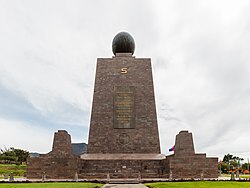
Back سيوداد ميتاد دل موندو Arabic Ciudad Mitad del Mundo Catalan Mitad del Mundo Czech Mitad del Mundo German Ciudad Mitad del Mundo Spanish Mitad del mundo French עיר אמצע העולם HE Mitad del Mundo Hungarian ミッター・デル・ムンド Japanese Mitad del Mundo LT
| Ciudad Mitad del Mundo | |
|---|---|
 The Monument to the Equator (Monumento a la Mitad del Mundo) | |
 | |
| Type | Museum park and monument |
| Location | San Antonio parish, Quito, Ecuador |
| Coordinates | 0°00′08″S 78°27′21″W / 0.00222°S 78.45583°W |
| Operated by | Prefecture of Pichincha |
| Status | Open all year |



The Ciudad Mitad del Mundo (Middle of the World City) is a tract of land owned by the prefecture of the province of Pichincha, Ecuador. It is located at San Antonio parish of the canton of Quito, 26 km (16 mi) north of the center of Quito. The grounds contain the Monument to the Equator, which highlights the exact location of the Equator (from which the country takes its name) and commemorates the eighteenth-century Franco-Spanish Geodesic Mission which fixed its approximate location; they also contain the Museo Etnográfico Mitad del Mundo, Ethnographic Museum Middle of the Earth, a museum about the indigenous people ethnography of Ecuador.
The 30-metre-tall (98 ft) monument was constructed between 1979 and 1982 by Architect and Contractor Alfredo Fabián Páez with Carlos Mancheno President of Pichincha's Province Council to replace an older, smaller monument built by the Government of Ecuador under the direction of the geographer Luis Tufiño in 1936.[1] It is made of iron and concrete and covered with cut and polished andesite stone. The monument was built to commemorate the first Geodesic Mission of the French Academy of Sciences, led by Louis Godin, Pierre Bouguer and Charles Marie de La Condamine, who, in the year 1736, conducted experiments to test the flattening at the poles of the characteristic shape of the Earth, by comparing the distance between a degree meridian in the equatorial zone to another level measured in Sweden.[2] The older monument was moved 7 km (4.3 mi) to a small town near there called Calacalí.[3]

The UNASUR former headquarters is located in this place,[4] but is now in disuse following Ecuador's withdrawal from the organization in 2019.[5] Contrary to popular belief[which?], there are only two points of interest positioned exactly on the equator: the Catequilla archaeological site,[6][7] and the Quitsato Sundial.[8]
- ^ Del Castillo, Eduardo (1986). Geografía del Ecuador. Quito-Ecuador: Libresa. p. 5. ISBN 997880029-8.
- ^ Lafuente, Mazuecos, Antonio (1992). Los Caballeros del Punto Fijo. Abya-Yala. p. 70.
- ^ Del Castillo, Eduardo (1986). Geografía del Ecuador. Quito-Ecuador: Libresa. p. 6. ISBN 997880029-8.
- ^ "Llega Alí Rodríguez a Ecuador para asumir Secretaría General de Unasur". Spanish People Daily. 14 June 2012. Archived from the original on 4 February 2014. Retrieved 30 June 2012.
- ^ "Darle utilidad al edificio de la Unasur entre los planes del Ministerio de Cultura". 3 June 2021. Retrieved 3 June 2021.
- ^ Cobo, Cristóbal (2004). "El sitio arqueológico Sobre el Monte Catequilla en la Latitud Cero". Memorias del Simposio ARQ-13 del 51 Congreso Internacional de Americanistas (in Spanish). Chile: Pereira editores.
- ^ Awake!. "Nahua/Maya Number system AMAZING DISCOVERIES at EARTH'S EQUATOR". Archived from the original on 5 May 2012. Retrieved 8 July 2012.
- ^ Instituto Geográfico Militar de Ecuador (24 January 2005). "Memoria Técnica de la Determinación de la Latitud Cero" (in Spanish).